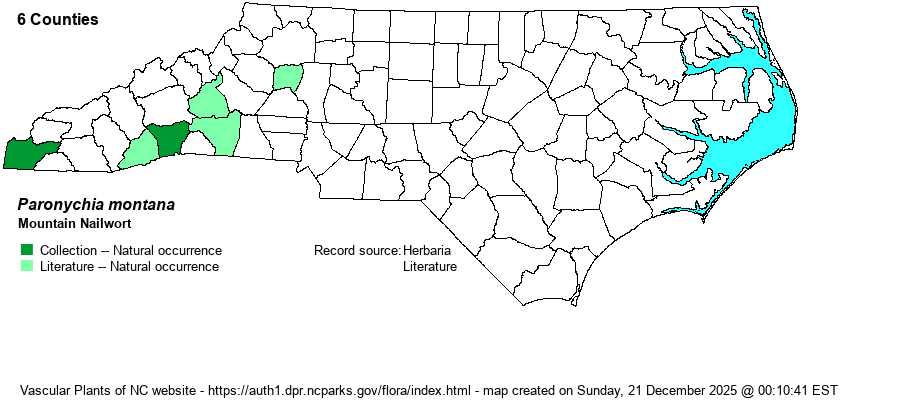| Section 6 » Order Caryophyllales » Family Caryophyllaceae |
Show/Hide Synonym
| taxonName | relationship | relatedTaxonName | relatedTaxonRefText | relComments |
|---|
|
|
|
|
| Paronychia montana | < | Paronychia fastigiata | Radford, Ahles, and Bell (1968) | | | Paronychia montana | < | Paronychia fastigiata | Wofford (1989) | | | Paronychia montana | = | Paronychia fastigiata var. pumila | Gleason and Cronquist (1991) | | | Paronychia montana | = | Paronychia fastigiata var. pumila | Fernald (1950) | | | Paronychia montana | = | Paronychia fastigiata var. pumila | Flora of North America (1993b, 1997, 2000, 2002a, 2002b, 2003a, 2004b, 2005, 2006a, 2006b, 2006c, 2007a, 2009, 2010) | | | Paronychia montana | = | Paronychia fastigiata var. pumila | Gleason (1952) | | | Paronychia montana | = | Paronychia fastigiata var. pumila | | | | Paronychia montana | = | Anychiastrum montanum | Small (1933, 1938) | | | Source: Weakley's Flora |
|
| Author | (Small) Pax & K. Hoffmann | |
| Distribution | Present at scattered sites in the southern Mountains and western Piedmont (on monadnocks).
This is a Central and Southern Appalachian endemic, ranging from PA southwest to northern GA. Oddly, it has not yet been recorded from the northern half of the NC mountains. | |
| Abundance | Rare to locally uncommon in the southern Mountains, and very rare in the Piedmont (found in the Brushy Mountains in Alexander County). The NCNHP considers it as a Watch List species, but with a State Rank of S1? The website editors suggest S1S2 as a better rank. | |
| Habitat | This species is found most often in its range in shale barrens, but these are absent in NC. In the state, it appears to occur mostly on sunny, exposed granitic domes, perhaps less so on other exposed rock outcrops. Rock type and soil pH are not yet clarified in the state at the present time. | |
| Phenology | Blooms from June to October, and fruits soon after flowering. | |
| Identification | This is a low-growing member of the genus -- often just 4-6 inches tall, quite similar to the much more numerous P. fastigiata and P. canadensis, though those grow somewhat more in shade or partial shade than does P. montana. P. montana has a shorter or wider appearance than those two, with horizontally or more wide-spreading branches rather than strongly ascending. The leaves are shorter, often only about 1/2-inch long or less, narrowly elliptic and tapered (cuneate) to the base, as in P. fastigiata. Check with Weakley (2018) for additional separation characters. | |
| Taxonomic Comments | This species has often been named as P. fastigiata var. pumila in references, including some recent ones.
| |
| Other Common Name(s) | Shale Barren Nailwort, Shale Barren Whitlow-wort | |
| State Rank | S1? [S1S2] | |
| Global Rank | G4 | |
| State Status | W7 | |
| US Status | | |
| USACE-agcp | | |
| USACE-emp | | |

